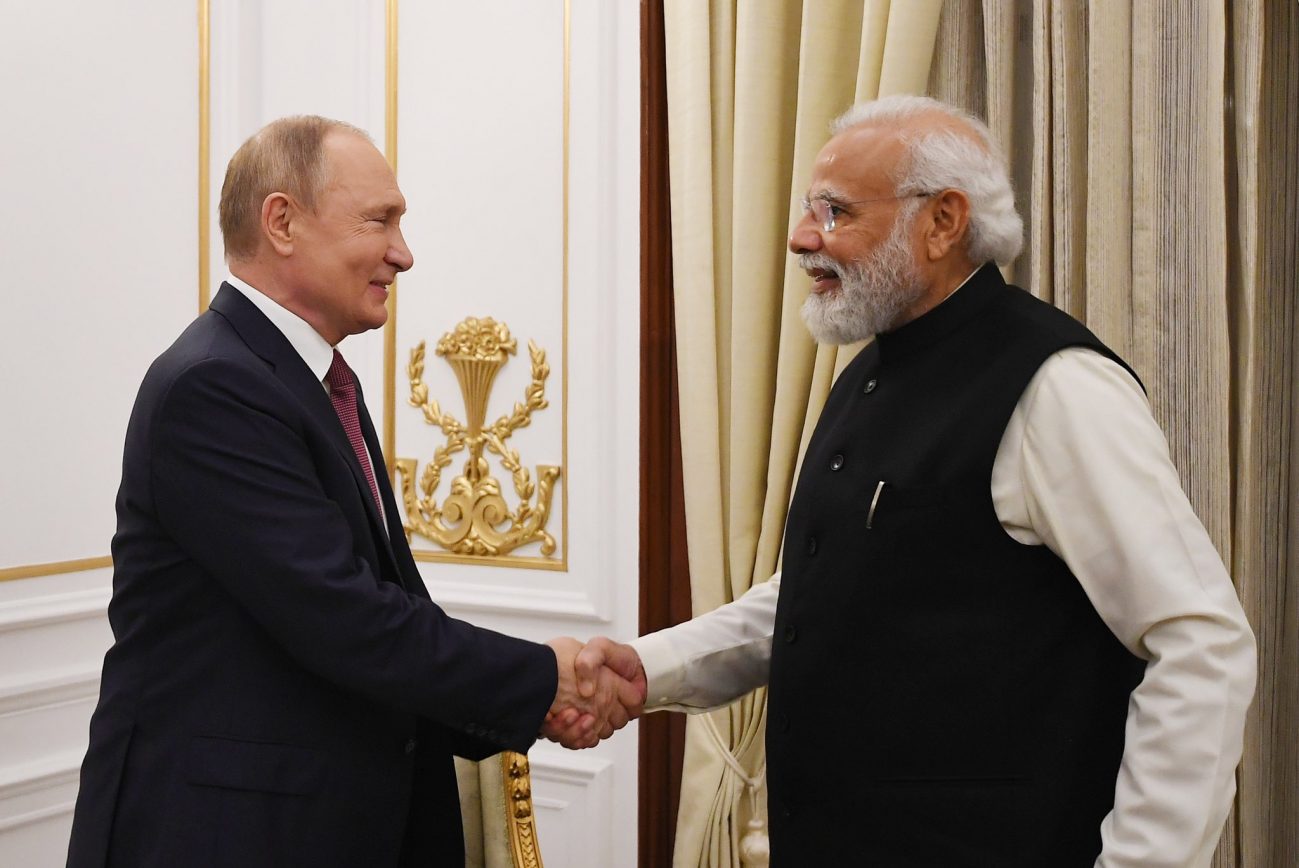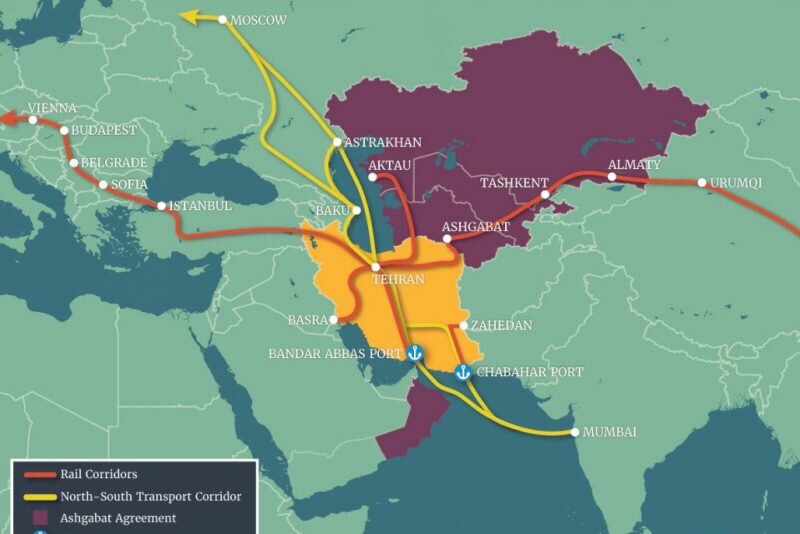The International North-South Transport Corridor (INSTC) initiative by Russia, Iran, and India to enhance trade and transport connectivity among countries along its route could not only help Russia and Iran counter Western sanctions but may also benefit the global economy to move away from the now-dangerous Red Sea and the Suez link to the Mediterranean.
Imposing economic sanctions has become a preferred tool of the Western developed countries, especially the US, to punish a defiant state. For these powers, defiance means anything that does not fit their interests and perceptions. This is how the hegemony of the powerful is demonstrated.
One aspect of the sanctions regime is controlling trade routes by maintaining surveillance over the waterways or roadways over which cargo moves across the globe. In recent times, overland highways—China’s Belt and Road Initiative is an example—have gained great importance as a means of connectivity for economic and security purposes.
International North-South Transport Corridor (INSTC)
The idea of building the International North-South Transport Corridor (INSTC) sprang up due to the imposition of sanctions on Russia. Moscow began exploring alternative markets for its products that would not need transportation through vulnerable or forbidden connectivity.
The INSTC plan comprises a 7,200-km corridor starting from St Petersburg in Russia to ports in southern Iran and from there to Mumbai in India. The idea is of a shipping route that should bypass Europe. It will also reduce the length of the current path through the Mediterranean Sea and the Suez Canal to Russia by almost half.
The corridor will connect Russia with Iran through three routes. The main route, the West Caspian route, passes through Azerbaijan via rail and road. The central route transits through the Caspian Sea by ship, and the eastern path follows the Caspian Sea’s eastern shore.
Azerbaijan Terminus
Substantial progress has been made in building the western route. Nikkei on March 12 reported that the Azerbaijan Ministry of Digital Development and Transport had told its correspondent that rail freight had grown roughly 30 percent last year, while road freight rose 35 percent to 1.3 million tonnes.
Azerbaijan expects total freight traffic to reach 30 million tonnes per year. To this end, it plans to construct a railway and road crossing the Aras River, which runs along its border with Iran.
A four-lane toll road connecting the Azerbaijani capital, Baku, with the Russian border, opened in October last year following the March 2023 opening of the customs checkpoint in the area.
A Blessing In Disguise
Many commentators have termed the imposition of sanctions on Russia a blessing in disguise. Three countries, Russia, Iran, and India, first agreed to the plan as early as 2000. However, recent political realignments in the region became the catalyst for advancing the plan.
The sanctions on Russia shifted the importance of the Mediterranean trade route to the Azerbaijan grid. Russia sought Asian and Middle Eastern export markets for its products. Simultaneously, as Iran was also reeling under sanctions, Tehran evinced keen interest in the newly contemplated North-South connectivity, which it came to be called.
The plan got reinforcement from the recent events in the Red Sea and also the Israel-Hamas clashes in the Middle East. The Iran-backed Houthi attacks on mercantile shipping across the Red Sea exposed the insecurity of the Suez link to the Mediterranean.
The UK and US had to move their naval ships to the region to provide security to commercial vessels. Reflecting on the importance of North-South Sea transportation, Russian Deputy Prime Minister Alexei Overchuk told the Russian media in January this year: “Given what is seen in the Red Sea region, the North-South corridor will gain global significance.”
The Indian Minister of External Affairs, S Jaishankar, pointed out that “it is in the interests of the global economy that this corridor progresses.”

Impact
The development of the North-South corridor will shift the commercial importance of the Red Sea-Mediterranean link to the new South Caucasian region corridor.
The project has already begun to show its impact. Iran, for example, supplied drones to Russia unhindered by the sanctions imposed on it. Moscow has received drones and other military equipment.
Second, the corridor has brought Azerbaijan and Russia closer than ever, which has boosted the Azerbaijan government’s morale in its impending tensions with Armenia, which is receiving a lot of Western support.
The impact is not to be construed only in military terms. Its commercial importance is uppermost because that impacts the lives of millions of people.
In one way, the impact of the North-South corridor has been adverse on Armenia, no doubt. Armenia and Azerbaijan have been at loggerheads for a long time over the autonomous region of Nagorno-Karabakh.
Armenia had to bid goodbye to Karabakh because of the apathy of Moscow and the aggressive designs of Azerbaijan bolstered by Erdogan’s (Turkey) hawkish regime.

The North-South corridor can potentially transform the lives of millions of people in the region by opening new avenues of economic activity, easy mobility, and freedom from the adverse impact of economic sanctions.
Azerbaijan is an important point on the road linking Europe with China via the Caspian Sea. It is also a supplier of oil and natural gas to Europe through pipelines.
Previously, Azerbaijan was not on good terms with Iran due to Azerbaijan’s pro-Turkey stance. At that time, Armenia had come closer to Iran essentially through the large Armenian diaspora in Iran.
However, that situation has changed now, and the Iranian foreign minister bluntly told his Armenian counterpart during the latter’s visit to Tehran not to open up freely to the Jewish state of Israel and its allies.
Armenia
Alarmed by the far-reaching geopolitical changes stemming from the North-South corridor project, Armenia put forward a proposal.
Armenia’s Prime Minister Nikol Pashiniyan presented the “Crossroads of Peace” proposal in October last year, which envisioned a north-south and east-west network of rail and road through which Armenia hopes to reopen its borders with Azerbaijan and Turkey.
Indian External Affairs Minister S Jaishankar paid his maiden visit to Yerevan, the Armenian capital, in October 2021.
Political pundits believe that the recent rise in India-Armenia relations is the need of the hour amidst the crucial geopolitical game in the South Caucasus region. Armenia desires India to try to balance the fractured geopolitical situation in the South Caucasus, which has witnessed regional power rivalry, conflict over territory, and war as well.
- Prof. KN Pandita (Padma Shri) is the former director of the Center of Central Asian Studies at Kashmir University.
- This article contains the author’s personal views.
- Follow EurAsian Times on X (formerly Twitter)




